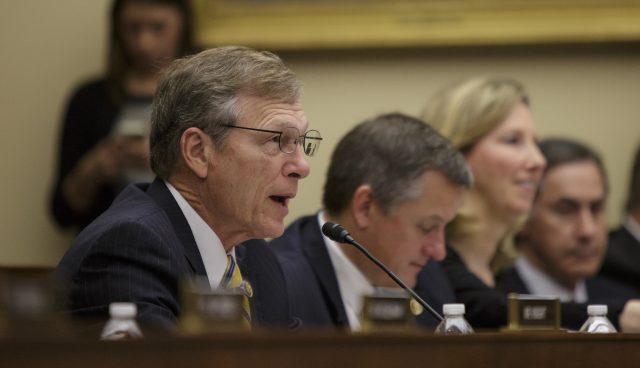
For the last half-decade, NASA has resolutely declared that it has embarked on a Journey to Mars. Virtually every agency achievement has, in one way or another, been characterized as furthering this ambition. Even last summer when the New Horizons spacecraft flew by Pluto, NASA Administrator Charles Bolden said it represented “one more step” on the Journey to Mars.
But as the end of President Obama’s second term in office nears, Congress has begun to assess NASA’s Mars ambitions. On Wednesday during a House space subcommittee hearing, legislators signaled that they were not entirely pleased with those plans. Comments from lawmakers, and the three witnesses called to the hearing, indicate NASA’s Journey to Mars may receive some pushback in the next year or two.
Some of the most critical testimony came from John Sommerer, a space scientist who spent more than a year as chairman of a National Research Council technical panel reviewing NASA’s human spaceflight activities. That panel’s work, summarized in a 2014 report titled Pathways to Exploration, considered possible pathways to Mars.
“While sending humans to Mars, and returning them safely to the Earth, may be technically feasible, it is an extraordinarily challenging goal, from physiological, technical, and programmatic standpoints,” Sommerer testified. “Because of this extreme difficulty, it is only with unprecedented cumulative investment, and, frankly, unprecedented discipline in development, testing, execution, and leadership, that this enterprise is likely to be successful.”
He implied that NASA presently had none of this in sufficient quantities. According to Sommerer, the technical panel found that it would take NASA 20 to 40 years to send humans to the surface of Mars at a staggering cost of approximately half a trillion dollars.
As it has promoted the Mars mission, NASA has studiously avoided any discussion of total costs to put humans on Mars. Bolden and other top officials have said the agency could achieve its goal with the agency’s existing budget, plus inflation. But for the agency’s exploration programs, the total funding available comes to about $180 billion (£120 billion) over the next 20 years. Spending only that amount would require abandoning the International Space Station next year, which NASA has no intention of doing.
Sommerer told Congress that the nation either needs to commit wholeheartedly to a Mars mission, or the agency should stop pretending it is on the course to go there with humans. “It might be better to stop talking about Mars if there is no appetite in Congress and the Administration for higher human spaceflight budgets and more disciplined execution by NASA,” he said.
Members of the House science community seemed disinclined to substantially increase NASA’s budget. Several, including Alabama Republican Mo Brooks, cited the country’s deficit and need to rein in spending, not increase it. The comments were notable coming from Brooks, whose district includes Huntsville and the Marshall Space Flight Center.
Another panelist, Tom Young, the former director of NASA’s Goddard Space Flight Center and former president and chief operating officer of the Martin Marietta Corporation, agreed that NASA does not currently have a clear pathway to Mars. “What we do not have is a plan, strategy, or architecture with sufficient detail that takes us from today to humans on the surface of Mars,” he said.
Young said he favored continuing with a mission to Mars but that following such a course required hard choices and narrowing NASA's focus. The agency cannot both have a flourishing program in low Earth orbit with the International Space Station while also trying to mount a Mars exploration program, he argued.
Agency officials have said they are not ready to talk in detail about Mars plans because they are evolving. NASA hopes to develop cost-cutting methods along the way, possibly including harvesting water ice on the Moon, to make Mars more affordable. NASA has said it will begin to detail plans for Mars in about five years.
Despite the lack of a well-defined pathway, NASA's Bolden warned in late 2015 that the space agency was “doomed” if Congress or the next president refocused the space agency’s human spaceflight goals away from Mars. With a transition looming next year to a new president, the panelists were deeply skeptical that such generalities would survive the scrutiny of a new White House.
“A new administration will be in place in about a year,” Young said. “Without a plan it will be difficult to obtain support for Mars and avoid another redo of the content and focus of the United States human spaceflight program.”
Two of the three experts who testified favored a more pragmatic approach, focusing on stepwise exploration by moving from low-Earth orbit to cislunar space near the Moon and then to the lunar surface itself. This would allow NASA to both achieve meaningful exploration goals and engage the burgeoning private space sector, which has been hungering to develop lunar resources. International partners are also more interested in the Moon than Mars.
This approach appeared to intrigue some Republican legislators, including subcommittee Chairman US Rep. Brian Babin, a Texan whose district includes Johnson Space Center. This group seemed eager to consider a Moon-first approach to exploration of the Solar System and sympathetic to the idea that America has unfinished business there after the Apollo program.
“In 2010 President Obama attempted to cancel deep space exploration and a return to the Moon by flippantly stating we’ve been there before,” Babin said during the hearing. “Thankfully presidents Eisenhower and Kennedy did not take the same tact and wash their hands of space exploration after we successfully placed a satellite and a human in space.”
reader comments
201